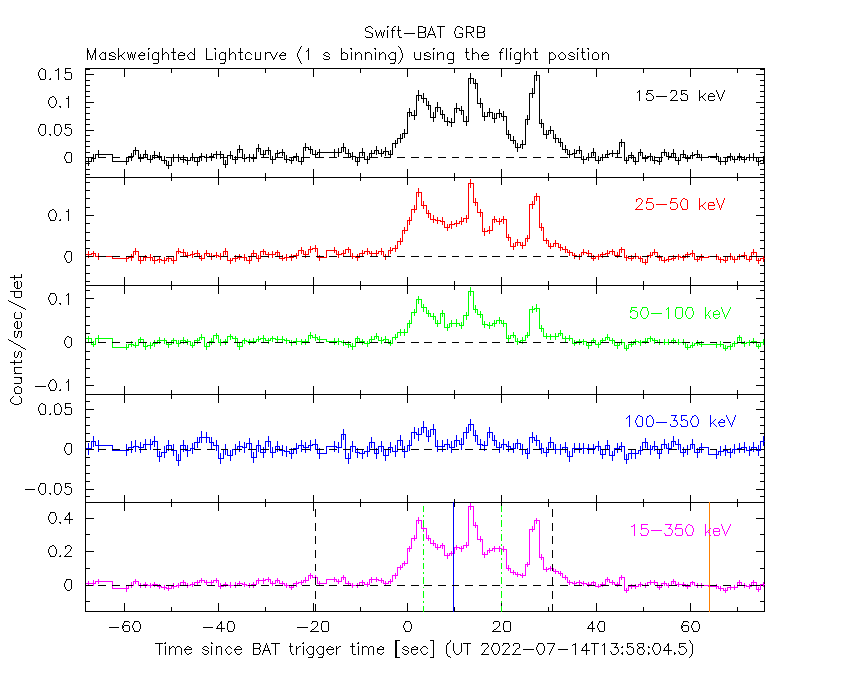
S. Laha (GSFC/UMBC), M. Perri (SSDC and INAF-OAR) and F.E. Marshall (NASA/GSFC) for the Swift team
At 13:58:04 UT, the Swift Burst Alert Telescope (BAT) triggered and located GRB 220714B (trigger=1116221) (Laha et al. GCN Circ. 32393). Swift slewed immediately to the burst. At the time of the trigger, the initial BAT position was 77° from the Sun (4.4 hours West) and 91° from the 99%-illuminated Moon. Table 1 contains the best reported positions from Swift, and the latest XRT position can be viewed at http://www.swift.ac.uk/xrt_positions.
Kuin and Laha (GCN Circ. 32413) reported the detection with UVOT of an optical afterglow. Table 2 is a summary of GCN Circulars about this GRB from observatories other than Swift.
Standard analysis products for this burst are available at https://gcn.gsfc.nasa.gov/swift_gnd_ana.html.
As reported by Laha et al. (GCN Circ. 32403),
the BAT ground-calculated position is
RA, Dec = 47.086, -19.321 deg which is
RA(J2000) = 0
The mask-weighted light curve (Figure 1) shows a complex structure.
The main period of
emission starts around T-5 s and continues to T+35 seconds with three main
overlapping pulses.
There is some precursor activity starting as early as T-45
seconds and low-level emission extending to T+60 seconds.
The spacecraft
slewed away from the burst location at around T+275 seconds.
The time-averaged spectrum from -48.27 to +45.75 s is best fit by a simple
power-law model.
The power law index of the time-averaged spectrum is
1.92 ± 0.07.
The fluence in the 15-150 keV band is 4.4 ± 0.1 x 1
The results of the batgrbproduct analysis are available at https://gcn.gsfc.nasa.gov/notices_s/1116221/BA/.
Analysis of the initial XRT data was reported by Perri et al. (GCN Circ. 32398). We have analysed 25 ks of XRT data for GRB 220714B, from 71 s to 354.7 ks after the BAT trigger. The data comprise 135 s in Windowed Timing (WT) mode (the first 4 s were taken while Swift was slewing) with the remainder in Photon Counting (PC) mode. The enhanced XRT position for this burst was given by Evans et al. (GCN Circ. 32395).
The late-time light curve (Figure 2) (from T0+3.5 ks) can be modelled with a power-law decay with a decay index of α=1.260 ± 0.026.
A spectrum formed from the WT mode data can be fitted with an absorbed power-law with a photon spectral index of 3.95 (+0.19, -0.18). The best-fitting absorption column is 2.7 ± 0.3 x 1
A summary of the PC-mode spectrum is thus:
Total column: 1.47 (+0.28, -0.27) x 1
Galactic foreground: 3.2 x 1
Excess significance: 7.0 σ
Photon index: 2.03 ± 0.10
The results of the XRT team automatic analysis are available at http://www.swift.ac.uk/xrt_products/01116221.
Analysis of the UVOT data was reported by Marshall and Laha (GCN Circ. 32396).
UVOT took a finding chart exposure of 150 seconds with the White filter
starting 3552 seconds after the BAT trigger.
Table 3 gives preliminary
magnitudes using the UVOT photometric system
(Breeveld et al. 2011, AIP Conf. Proc., 1358, 373).
No correction has been made for the expected extinction in the Milky Way
corresponding to a reddening of
The Swift/UVOT began settled observations
(Kuin and Laha GCN Circ. 32413) of the field of GRB 220714B 3628 s after the BAT trigger and detected a bright afterglow (Marshall & Laha, GCN Circ. 32396).
Marshal and Laha provided the UVOT position of GRB 220714B.
Table 3 gives preliminary
magnitudes using the UVOT photometric system
(Breeveld et al. 2011, AIP Conf. Proc., 1358, 373).
No correction has been made for the expected extinction in the Milky Way
corresponding to a reddening of

Figure 1. The BAT
mask-weighted light curve in the four individual and total
energy bands. The units are counts

Figure 2. The XRT light curve.
Any data from a crosshatched region are not included in the fit.
| RA (J2000) | Dec (J2000) | Error | Note | Reference |
|---|---|---|---|---|
| 0 |
-19°19'45.3" | 0.61" | UVOT | GCN Circ. 32396 |
| 0 |
-19°19'46.6" | 1.9" | XRT-final | UKSSDC |
| 0 |
-19°19'46.6" | 2.1" | XRT-enhanced | Evans et al. GCN Circ. 32395 |
| 0 |
-19°19'13.8" | 1.3' | BAT-refined | Laha et al. GCN Circ. 32403 |
| Band | Authors | GCN Circ. | Subject | Observatory | Notes |
|---|---|---|---|---|---|
| Optical | Strausbaugh and Cucchiara | 32400 | LCO Optical Observations | LCO | detection |
| Gamma-ray | Fermi | 32392 | Fermi GBM Final Real-time Localization | Fermi GBM | |
| Gamma-ray | Dalessi et al. | 32402 | Fermi GBM observation | Fermi GBM | Fluence=8.0±0.4x1 (brighter than 69% of long GRBs) |
Table 3. Found no UVOT observations.
July 19, 2022